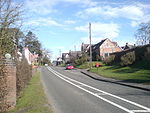Lowsonford
Villages in WarwickshireWarwickshire geography stubs

Lowsonford is a small village within the parish of Rowington in Warwickshire, England. The village lies 4 miles (6.4 km) north-east of Henley-in-Arden.
Excerpt from the Wikipedia article Lowsonford (License: CC BY-SA 3.0, Authors, Images).Lowsonford
Lapworth Street,
Geographical coordinates (GPS) Address Nearby Places Show on map
Geographical coordinates (GPS)
| Latitude | Longitude |
|---|---|
| N 52.3089 ° | E -1.72714 ° |
Address
Lapworth Street
Lapworth Street
B95 5HJ
England, United Kingdom
Open on Google Maps









